Potential Variation of Evapotranspiration Induced by Typical Vegetation Changes in Northwest China
Abstract
:1. Introduction
2. Materials and Methods
2.1. Study Area
2.2. Study Data
2.2.1. Land Cover and Preprocessing
2.2.2. Evapotranspiration and Preprocessing
2.2.3. Subecoregion Vector
2.2.4. NDVI and Preprocessing
2.3. Methods
2.3.1. Land Cover Transfer Matrix
2.3.2. Extraction of Changed Pixels
2.3.3. Method of Absolute Change
2.3.4. Method of Relative Change
3. Results and Discussion
3.1. Vegetation Changes in Northwest China
3.2. Annual ET of Typical Vegetation in Different Regions
3.3. Effect of Typical Vegetation Changes on ET
3.3.1. Effect of Typical Vegetation Changes on Inter-annual ET
3.3.2. Effect of Typical Vegetation Changes on Seasonal ET
4. Conclusions
Author Contributions
Funding
Acknowledgments
Conflicts of Interest
References
- Burman, R.; Pochop, L.O. Evaporation, evapotranspiration and climatic data. J. Hydrol. 1994, 190, 167–168. [Google Scholar]
- Fisher, J.B.; Melton, F.; Middleton, E.; Hain, C.; Anderson, M.; Allen, R.; McCabe, M.F.; Hook, S.; Baldocchi, B.; Townsend, P.A. The future of evapotranspiration: Global requirements for ecosystem functioning, carbon and climate feedbacks, agricultural management, and water resources. Water Resour. Res. 2017, 53, 2618–2626. [Google Scholar] [CrossRef]
- Wang, K.C.; Dickinson, R.E. A review of global terrestrial evapotranspiration: Observation, modeling, climatology, and climatic variability. Rev. Geophys. 2012, 50, RG2005. [Google Scholar] [CrossRef]
- Li, C.J.; Hu, S.J.; Zheng, B.W. Energy balance and evapotranspiration characteristics of Haloxylon ammodendron community in the southern margin of the Gurbantunggut Desert. Acta Ecol. Sin. 2021, 41, 92–100. [Google Scholar]
- Ma, X.H.; Feng, Q. Energy partitioning and evapotranspiration of Populus euphratica forests in desert riparian area. Acta Ecol. Sin. 2020, 40, 8683–8693. [Google Scholar]
- Zhou, S.; Williams, A.P.; Lintner, B.R.; Berg, A.M.; Zhang, Y.; Keenan, T.F.; Cook, B.I.; Hagemann, S.; Seneviratne, A.I.; Gentine, P. Soil moisture–atmosphere feedbacks mitigate declining water availability in drylands. Nat. Clim. Chang. 2021, 11, 38–44. [Google Scholar] [CrossRef]
- Tang, R.; Zhao, Y.T.; Lin, H.L. Spatio-Temporal Variation Characteristics of Aboveground Biomass in the Headwater of the Yellow River Based on Machine Learning. Remote Sens. 2021, 13, 3404. [Google Scholar] [CrossRef]
- Arellano, J.V.; Heerwaarden, C.C.; Lelieveld, J. Modelled suppression of boundary-layer clouds by plants in a CO2-rich atmosphere. Nat. Geosci. 2012, 5, 701–704. [Google Scholar] [CrossRef]
- Hu, Z.M.; Wu, G.N.; Zhang, L.X.; Li, S.G.; Zhu, X.J.; Zheng, H.; Zhang, L.M.; Sun, X.M.; Yu, G.R. Modeling and Partitioning of Regional Evapotranspiration Using a Satellite-Driven Water-Carbon Coupling Model. Remote Sens. 2017, 9, 54. [Google Scholar] [CrossRef] [Green Version]
- Ptichnikov, A.V.; Shvarts, E.A.; Kuznetsova, D.A. The Greenhouse Gas Absorption Potential of Russian Forests and Possibilities for Carbon Footprint Reduction for Exported Domestic Products. Dokl. Earth Sci. 2021, 499, 683–685. [Google Scholar] [CrossRef]
- Miller, B.A.; Pearse, W.D.; Flint, C.G. Saving the Forest from the Trees: Expert Views on Funding Restoration of Northern Arizona Ponderosa Pine Forests through Registered Carbon Offsets. Forests 2021, 12, 1119. [Google Scholar] [CrossRef]
- Zhu, Z.C.; Piao, S.L.; Myneni, R.B.; Huang, M.T.; Zeng, Z.Z.; Canadell, J.G.; Ciais, P.; Sitch, P.; Arneth, A.; Cao, C.X. Greening of the Earth and its drivers. Nat. Clim. Chang. 2016, 6, 791–795. [Google Scholar] [CrossRef]
- Liu, M.; Tang, R.L.; Li, Z.L.; Gao, M.F.; Yao, Y.J. Progress of data-driven remotely sensed retrieval methodsand products on land surface evapotranspiration. Natl. Remote Sens. Bull. 2021, 25, 1517–1537. [Google Scholar]
- Running, S.; Mu, Q.Z. University of Montana and MODAPS SIPS—NASA. In MOD16A2 MODIS/Terra Evapotranspiration 8-day L4 Global 500m SIN Grid. NASA LP DAAC 2015. [Google Scholar] [CrossRef]
- Mu, Q.Z.; Heinsch, F.A.; Zhao, M.S.; Running, S.W. Development of a global evapotranspiration algorithm based on MODIS and global meteorology data. Remote Sens. Environ. 2007, 111, 519–536. [Google Scholar] [CrossRef]
- Mu, Q.Z.; Zhao, M.S.; Running, S.W. Improvements to a MODIS global terrestrial evapotranspiration algorithm. Remote Sens. Environ. 2011, 115, 1781–1800. [Google Scholar] [CrossRef]
- Liang, S.L.; Cheng, J.; Jia, K.; Jiang, B.; Liu, Q.; Xiao, Z.Q.; Yao, Y.J.; Yuan, W.P.; Zhang, X.T.; Zhao, X.; et al. The Global Land Surface Satellite (GLASS) product suite. Bull. Am. Meteorol. Soc. 2021, 102, E323–E337. [Google Scholar] [CrossRef]
- Jung, M.; Reichstein, M.; Margolis, H.A.; Cescatti, A.; Richardson, A.D.; Arain, M.A.; Arneth, A.; Bernhofer, C.; Bonal, D.; Chen, J.; et al. Global patterns of land-atmosphere fluxes of carbon dioxide, latent heat, and sensible heat derived from eddy covariance, satellite, and meteorological observations. J. Geophys. Res. 2011, 116, G00J07. [Google Scholar] [CrossRef] [Green Version]
- Hu, G.C.; Jia, L. Monitoring of Evapotranspiration in a Semi-Arid Inland River Basin by Combining Microwave and Optical Remote Sensing Observations. Remote Sens. 2015, 7, 3056–3087. [Google Scholar] [CrossRef] [Green Version]
- Wu, B.F.; Yan, N.N.; Xiong, J.; Bastiaanssen, W.G.M.; Zhu, W.W.; Stein, A. Validation of ETWatch using field measurements at diverse landscapes: A case study in Hai Basin of China. J. Hydrol. 2012, 436–437, 67–80. [Google Scholar] [CrossRef]
- He, T.; Shao, Q.Q. Temporal and spatial patterns of Evapotranspiration in China from 2001 to 2010 based on MOD16 products. J. Geo-Inf. Sci. 2014, 16, 979–988. [Google Scholar]
- Cai, D.; Ge, Q.; Wang, X.; Liu, B.; Goudie, A.S.; Hu, S. Contributions of ecological programs to vegetation restoration in arid and semiarid China. Environ. Res. Lett. 2020, 15, 114046. [Google Scholar] [CrossRef]
- Liu, J.Y.; Ning, J.; Kuang, W.H.; Xu, X.L.; Zhang, S.W.; Yan, Z.Z.; Li, R.D.; Wu, S.X.; Hu, Y.F.; Du, G.M.; et al. Spatio-temporal patterns and characteristics of land-use change in China during 2010–2015. Acta Geogr. Sin. 2018, 73, 5–8. [Google Scholar]
- Cheng, W.M.; Gao, X.Y.; Ma, T.; Xu, X.L.; Chen, Y.J.; Zhou, C.H. Spatial-temporal distribution of cropland in China based on geomorphologic regionalization during 1990–2015. Acta Geogr. Sin. 2018, 73, 1613–1629. [Google Scholar]
- Deng, X.; Shi, Q.; Zhang, Q.; Shi, C.; Yin, F. Impacts of land use and land cover changes on surface energy and water balance in the Heihe River Basin of China, 2000–2010. Phys. Chem. Earth 2015, 79, 2–10. [Google Scholar] [CrossRef]
- Chen, Y.L.; Wang, S.S.; Ren, Z.G.; Huang, X.Z.; Liu, S.S.; Deng, H.J.; Lin, W.K. Increased evapotranspiration from land cover changes intensified water crisis in an arid river basin in northwest China. J. Hydrol. 2019, 574, 383–397. [Google Scholar] [CrossRef]
- Qiu, L.J.; Wu, Y.P.; Shi, Z.Y.; Chen, Y.T.; Zhao, F.B. Quantifying the Responses of Evapotranspiration and Its Components to Vegetation Restoration and Climate Change on the Loess Plateau of China. Remote Sens. 2021, 13, 2358. [Google Scholar] [CrossRef]
- Qiu, L.J.; Wu, Y.P.; Shi, Z.Y.; Yu, M.; Zhao, F.B.; Guan, Y.H. Quantifying spatiotemporal variations in soil moisture driven by vegetation restoration on the Loess Plateau of China. J. Hydrol. 2021, 600, 126580. [Google Scholar] [CrossRef]
- Jiang, F.X.; Xie, X.H.; Liang, S.L.; Wang, Y.B.; Zhu, B.W.; Zhang, X.T.; Chen, Y.C. Loess Plateau evapotranspiration intensified by land surface radiative forcing associated with ecological restoration. Agric. For. Meteorol. 2021, 311, 108669. [Google Scholar] [CrossRef]
- Piao, S.L.; Nan, H.J.; Huntingford, C.; Ciais, P.; Friedlingstein, P.; Sitch, S.; Peng, S.S.; Ahlström, A.; Canadell, J.G. Evidence for a weakening relationship between interannual temperature variability and northern vegetation activity. Nat. Commun. 2014, 5, 5018. [Google Scholar] [CrossRef] [Green Version]
- Wang, H.H.; Zhao, J.; Yue, C.; Yu, Q. Cooling effect induced by afforestation on the loess plateau and its change law. J. Soil Water Conserv. 2021, 35, 214–220. [Google Scholar]
- Shuai, Y.M.; Masek, J.G.; Gao, F.; Schaaf, C.B.; He, T. An approach for the long-term 30-m land surface snow-free albedo retrieval from historic Landsat surface reflectance and MODIS-based a priori anisotropy knowledge. Remote Sens. Environ. 2014, 152, 467–479. [Google Scholar] [CrossRef]
- Gu, J.H.; Xue, H.Z.; Dong, G.T.; Zhou, L.J.; Li, J.R.; Dang, S.Z.; Li, S.Z. Effects of NDVI/ land use on spatial-temporal variation of Evapotranspiration in the Yellow River Basin. Arid. Land Geogr. 2021, 44, 158–167. [Google Scholar]
- Cui, Y.K.; Jia, L.; Fan, W.J. Estimation of actual evapotranspiration and its components in an irrigated area by integrating the Shuttleworth-Wallace and surface temperature-vegetation index schemes using the particle swarm optimization algorithm. Agric. For. Meteorol. 2021, 307, 108488. [Google Scholar] [CrossRef]
- Noormets, A.; Bracho, R.; Ward, E.; Seiler, J.; Strahm, B.; Lin, W.; McElligott, K.; Domec, J.C.; GonzalezBenecke, C.; Jokela, E.J. Heterotrophic respiration and the divergence of productivity and carbon sequestration. Geophys. Res. Lett. 2021, 48, e2020GL092366. [Google Scholar] [CrossRef]
- Chen, J.; Chen, J.; Gong, P.; Liao, A.P.; He, C.Y. Higher Resolution Global Land Cover Mapping. Geomat. World 2011, 9, 12–14. [Google Scholar]
- Chen, J.; Chen, J.; Lia, A.P.; Cao, X.; Chen, L.J.; Chen, X.H.; Peng, S.; Han, G.; Zhang, H.W.; He, C.Y. Concepts and key techniques for 30m global land cover mapping. Acta Geod. Cartogr. Sin. 2014, 43, 551–557. [Google Scholar]
- Chen, J.; Chen, J.; Liao, A.P.; Cao, X.; Chen, L.J.; Chen, X.H.; He, C.Y.; Han, G.; Peng, S.; Lu, M. Globalland cover mapping at 30 m resolution: A POK-based operational approach. ISPRS J. Photogramm. 2015, 103, 7–27. [Google Scholar] [CrossRef] [Green Version]
- Zhao, J.F.; Li, C.; Yang, T.Y.; Tang, Y.H.; Yin, Y.L.; Luan, X.B.; Sun, S.K. Estimation of high spatiotemporal resolution actual evapotranspiration by combining the SWH model with the METRIC model. J. Hydrol. 2020, 586, 124883. [Google Scholar] [CrossRef]
- He, L.; Chen, J.M.; Chen, J.; Liu, J.; Rogers, C.A. Diverse photosynthetic capacity of global ecosystems mapped by satellite chlorophyll fluorescence measurements. Remote Sens. Environ. 2019, 232, 111344. [Google Scholar] [CrossRef]
- Chen, J.M.; Liu, J. Evolution of evapotranspiration models using thermal and shortwave remote sensing data. Remote Sens. Environ. 2020, 237, 111594. [Google Scholar] [CrossRef]
- Yuan, W.P.; Zheng, Y.; Piao, S.L.; Ciais, P.; Lombardozzi, D.; Wang, Y.P.; Ryu, Y.; Chen, G.X.; Dong, W.J.; Hu, Z.M. Increased atmospheric vapor pressure deficit reduces global vegetation growth. Sci. Adv. 2019, 5, eaax1396. [Google Scholar] [CrossRef] [PubMed] [Green Version]
- Vanderhoof, M.K.; Williams, C.A. Persistence of MODIS evapotranspiration impacts from mountain pine beetle outbreaks in lodgepole pine forests, south-central Rocky Mountains. Agric. For. Meteorol. 2015, 200, 78–91. [Google Scholar] [CrossRef]
- Kamel, D. University of Arizona, Alfredo Huete—University of Technology Sydney and MODAPS SIPS—NASA. In MOD13A1 MODIS/Terra Vegetation Indices 16-Day L3 Global 500m SIN Grid. NASA LP DAAC 2015. [Google Scholar] [CrossRef]
- Rouse, J.W.; Haas, R.W.; Schell, J.A.; Deering, D.W.; Harlan, J.C. Monitoring the vernal advancement and retrogradation (green wave effect) of natural vegetation. NASA/GSFC Type III Final. Rep. Greenbelt. Md. 1974, 371, 1–112. [Google Scholar]
- Zhu, H.Y.; Li, X.B. Discussion on the Index Method of Regional Land Use Change. Acta Geogr. Sin. 2003, 58, 643–650. [Google Scholar]
- Hu, Q.; Ma, Y.X.; Xu, B.D.; Song, Q.; Tang, H.J.; Wu, W.B. Estimating Sub-Pixel Soybean Fraction from Time-Series MODIS Data Using an Optimized Geographically Weighted Regression Model. Remote Sens. 2018, 10, 491. [Google Scholar] [CrossRef] [Green Version]
- Wang, H.J.; Li, Z.; Cao, L.; Feng, R.; Pan, Y.P. Response of NDVI of Natural Vegetation to Climate Changes and Drought in China. Land 2021, 10, 966. [Google Scholar] [CrossRef]
- Pascolini-Campbell, M.; Reager, J.T.; Chandanpurkar, H.A.; Rodell, M. A 10 percent increase in global land evapotranspiration from 2003 to 2019. Nature 2021, 593, 543–547. [Google Scholar] [CrossRef]
- Yuan, C.C.; Zhang, D.X.; Liu, L.M.; Ye, J.W. Regional characteristics and spatial-temporal distribution of cultivated land change in China during 2009–2018. Trans. CSAE 2021, 37, 267–278. [Google Scholar]
- Wu, R.J.; Xing, X.R. Variation characteristics and influencing factors of actual evapotranspiration under various vegetation types: Acase study in the Huaihe River Basin, China. Chin. J. Appl. Ecol. 2016, 27, 1727–1736. [Google Scholar]
- Schwrzel, K.; Zhang, L.L.; Montanarella, L.; Wang, Y.H.; Sun, G. How afforestation affects the water cycle in drylands: A process-based comparative analysis. Glob. Chang. Biol. 2020, 26, 944–959. [Google Scholar] [CrossRef] [PubMed] [Green Version]
- Wang, W.Z.; Xu, F.N.; Wang, J.M. Energy Exchange and Evapotranspiration over the Ejina Oasis Riparian Forest Ecosystem with Different Land-Cover Types. Water 2021, 13, 3424. [Google Scholar] [CrossRef]
- Yan, J.X.; Ma, Y.F.; Zhang, D.Y.; Li, Z.C.; Zhang, W.K.; Wu, Z.H.; Wang, H.; Wen, L.H. High-Resolution Monitoring and Assessment of Evapotranspiration and Gross Primary Production Using Remote Sensing in a Typical Arid Region. Land 2021, 10, 396. [Google Scholar] [CrossRef]
- Zhang, Y.K.; Huang, M.B. Spatial variability and temporal stability of actual evapotranspiration on a hillslope of the Chinese Loess Plateau. J. Arid. Land 2021, 13, 189–204. [Google Scholar] [CrossRef]
- Liu, J.X.; Shen, W.H.; He, Y.Q. Effects of Cropland Expansion on Temperature Extremes in Western India from 1982 to 2015. Land 2021, 10, 489. [Google Scholar] [CrossRef]
- Yuan, X.L.; Bai, J.; Li, L.H.; Alishir, K.; Philippe, D.M.; Hui, D. The dominant role of climate change in determining changes in evapotranspiration in Xinjiang, china from 2001 to 2012. PLoS ONE 2017, 12, e0183071. [Google Scholar] [CrossRef] [Green Version]
- Wang, S.; Cui, C.F.; Dai, Q. Contributions of Vegetation Greening and Climate Change to Evapotranspiration Trend after Large-Scale Vegetation Restoration on the Loess Plateau, China. Water 2021, 13, 1755. [Google Scholar] [CrossRef]
- Hu, H.Y.; Zhu, L.; Li, H.X.; Xu, D.M.; Xie, Y.Z. Seasonal changes in the water-use strategies of three herbaceous species in a native desert steppe of Ningxia, China. J. Arid. Land 2021, 13, 109–112. [Google Scholar] [CrossRef]
- Chen, X. Retrieval and Analysis of Evapotranspiration in Central Areas of Asia; Meteorological Press: Beijing, China, 2012; pp. 182–202. [Google Scholar]


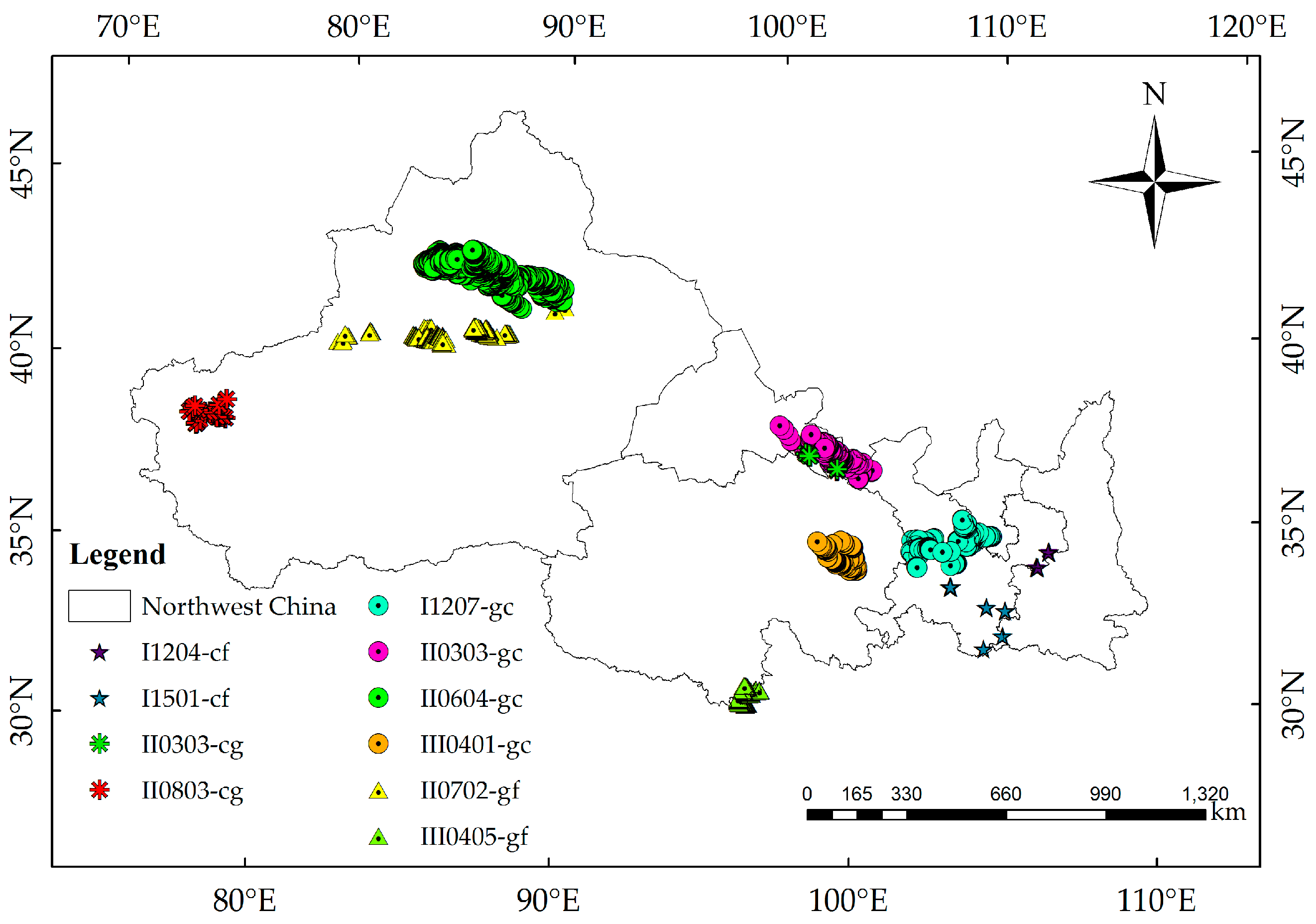
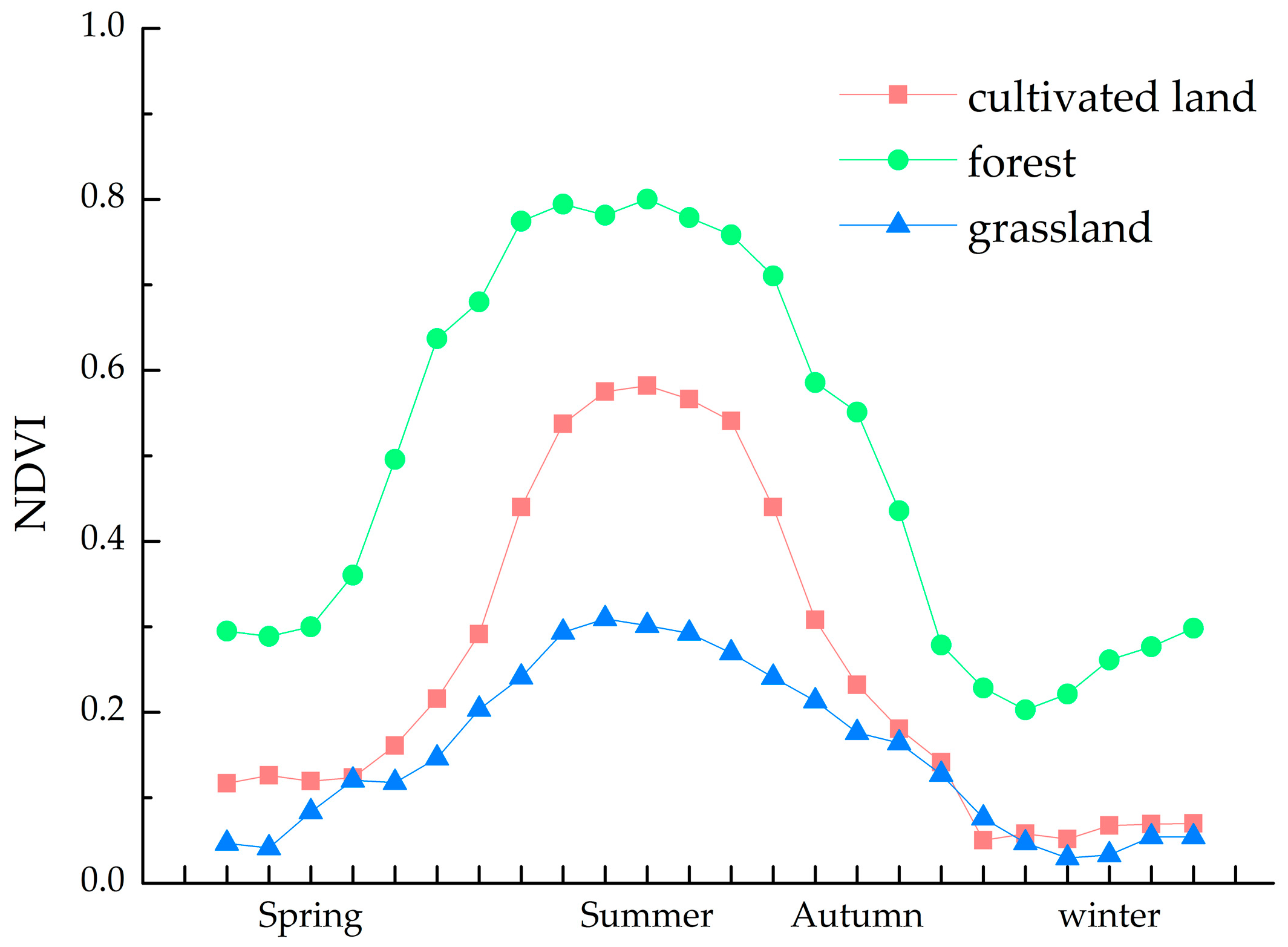
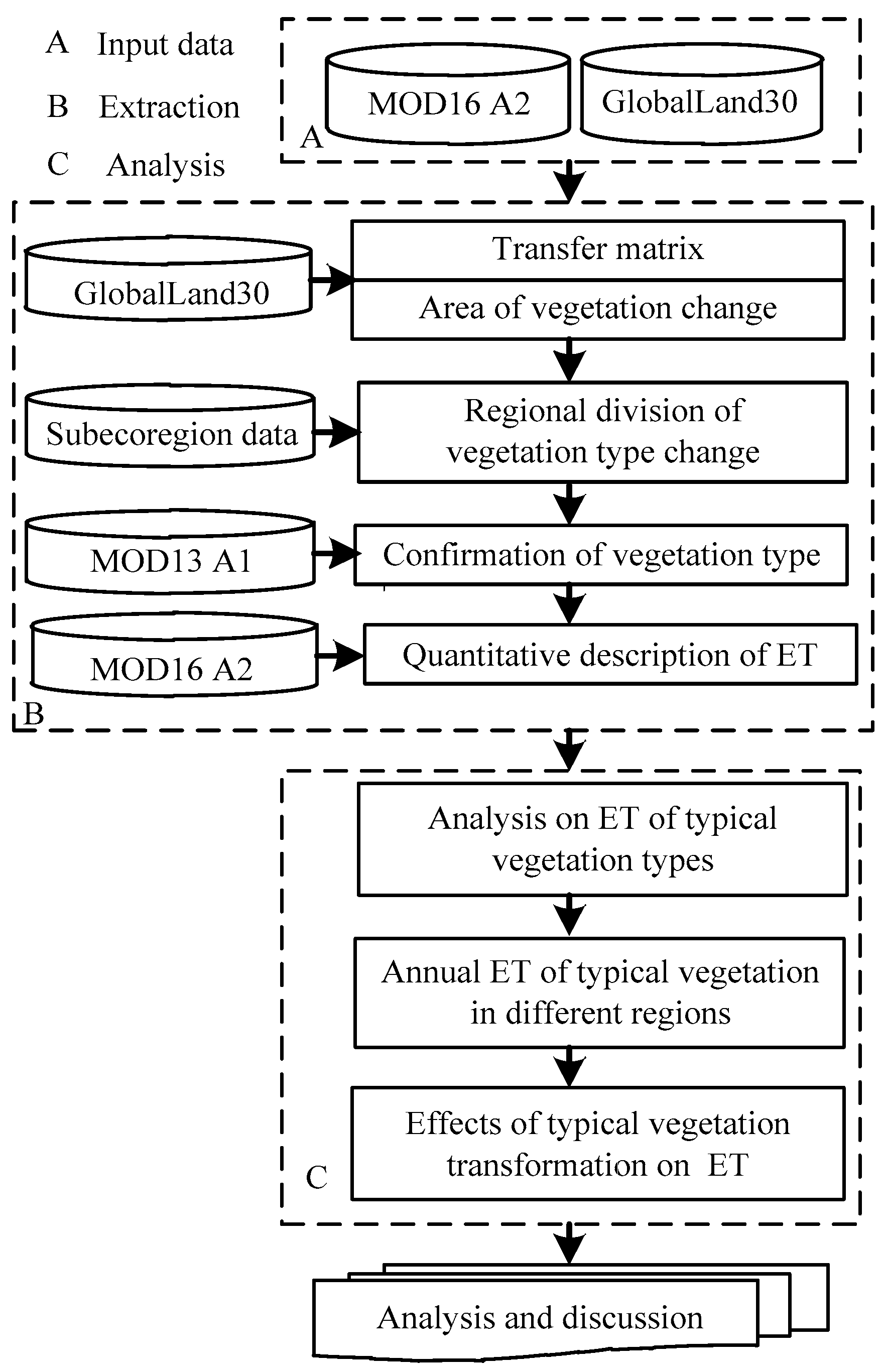

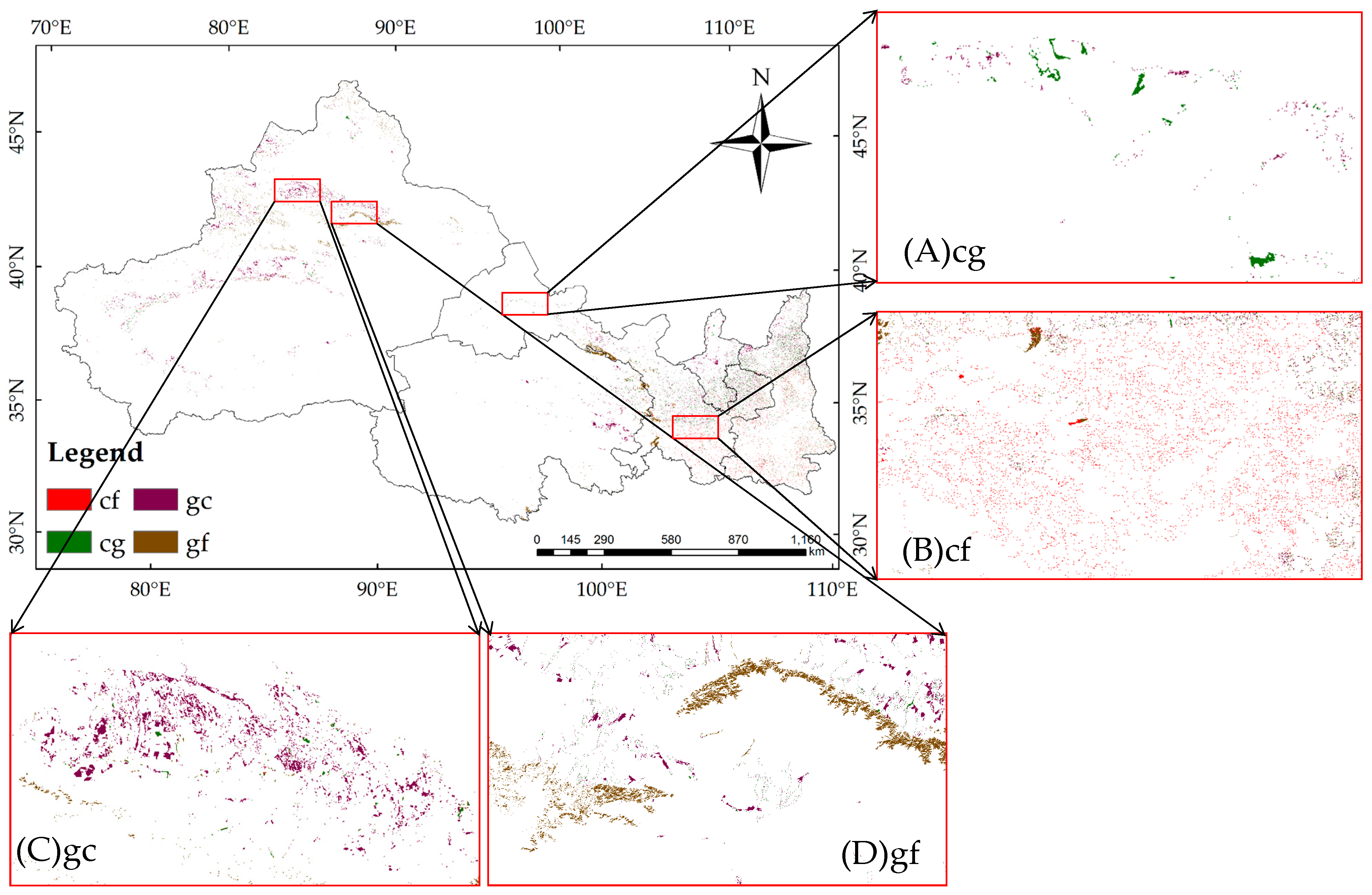
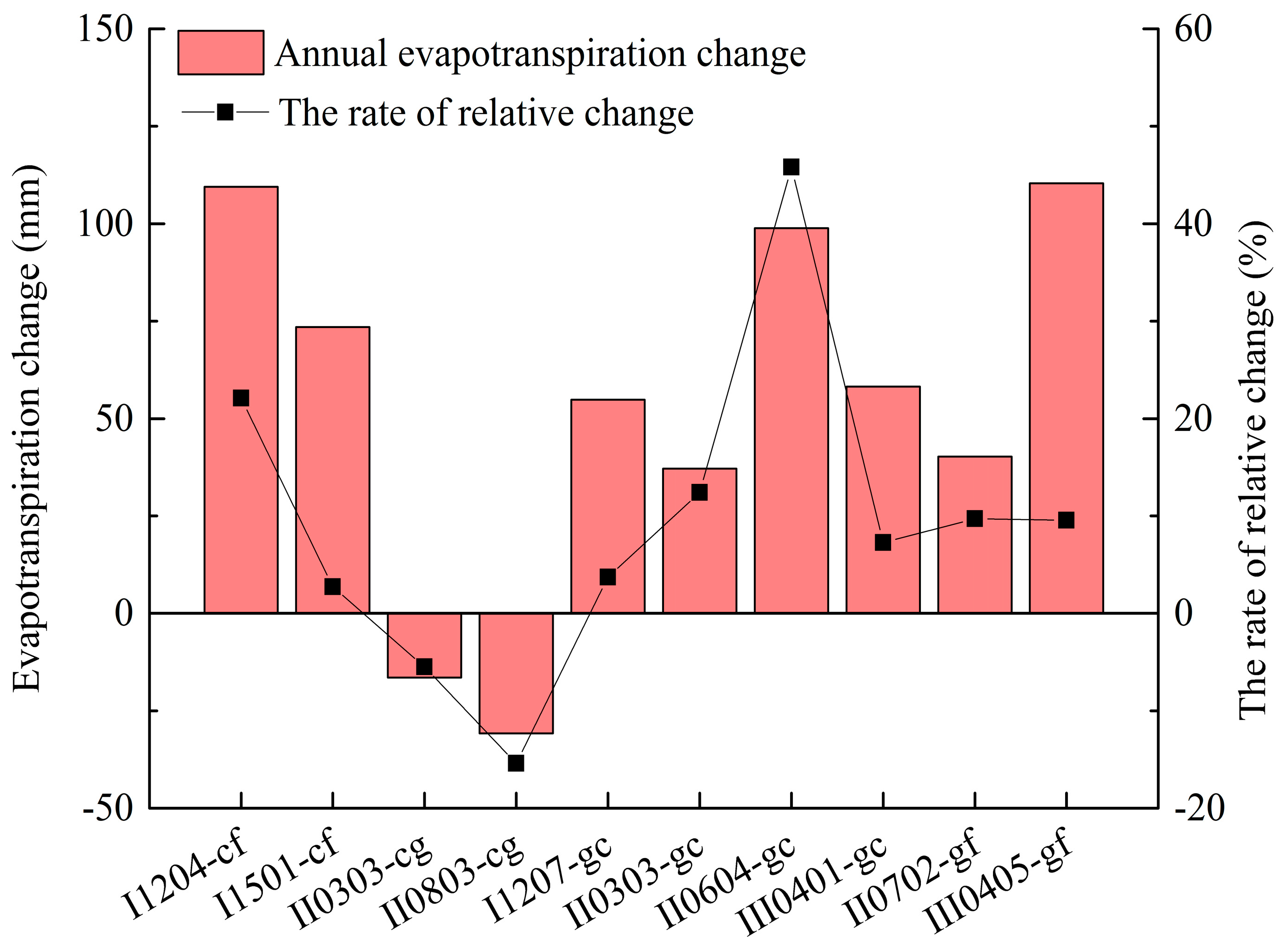

| DOY | PBIAS | DOY | PBIAS |
|---|---|---|---|
| 49 | −59.727 | 201 | −14.965 |
| 57 | −211.321 | 209 | −45.015 |
| 65 | −148.666 | 217 | −37.461 |
| 73 | −81.076 | 225 | −4.127 |
| 81 | −0.670 | 233 | 18.862 |
| 89 | −77.009 | 241 | 9.271 |
| 97 | −67.892 | 249 | 34.974 |
| 105 | −36.304 | 257 | −35.628 |
| 113 | 11.057 | 265 | −104.327 |
| 121 | 10.660 | 273 | −9.032 |
| 129 | −16.079 | 281 | −62.236 |
| 137 | 7.009 | 289 | −152.270 |
| 145 | −33.835 | 305 | −110.994 |
| 153 | 11.063 | 313 | −384.156 |
| 161 | 16.419 | 321 | −621.961 |
| 169 | 16.888 | 345 | −592.443 |
| 185 | −28.735 | 353 | −436.365 |
| 193 | −21.970 | 361 | −204.055 |
| Code | Name | Geographic Location |
|---|---|---|
| I1204 | Cultivated land and grassland subecoloregion of Loess hilly remnant tableland in southeast Gansu. | The subecoregion is located in the southern part of the Ningxia Hui Autonomous Region and the eastern part of Gansu province. |
| I1207 | Western agricultural subecoregion of Loess Plateau. | The subecoregion is located in the west of the Loess Plateau, the Loess hilly region in the middle of Gansu province, the Hulu River valley in the southwest of Ningxia, and the Liangmao hills on both sides. |
| I1501 | Subecoregion of deciduous broad-leaf conifer and broadleaf mixed forests in Qinling Mountains. | The subecoregion is located in the Qinling mountains, across Gansu, Shaanxi, and Henan provinces. |
| II0303 | Arid desert oasis agricultural subecoregion in Hexi Corridor. | The subecoregion is located in the eastern section of the Hexi Corridor in Gansu province. |
| II0604 | Desert, and shrubby and semishrubby oasis agricultural subecoregion in southern Junggar Basin. | The subecoregion is located in the south and southeast of Junggar Basin. The piedmont plain of the northern foot of the Tianshan Mountain reaches the foot of the Tianshan Mountain in the south, the southern boundary of the Goulban Tungut Desert in the north, the western boundary of the city of Wusu in the west, and the Baitou township of Autonomous County Muleh Kazakh in the east. |
| II0702 | Desert steppe–oasis agricultural subecoregion on the southern slope of Tianshan Mountains. | The subecoregion is located in western and central Xinjiang. |
| II0803 | Desert oasis agricultural subecoregion in northern Tarim Basin. | The subecoregion is located in the northern part of Tarim Basin, Tianshan piedmont plain, Kashgar Delta and Tarim River alluvial plain. |
| III0401 | Alpine grassland subecoregion in Gonghe Basin. | The subecoregion is located in the Gonghe Basin south of Qinghai Lake. |
| III0405 | Alpine meadow grassland subecoregion of Lancang River source. | The subecoregion is located in the southern most part of Autonomous Prefecture Qinghai Yushu Tibet. |
| 2010 | |||||
|---|---|---|---|---|---|
| Cultivated Land | Forest | Grassland | Total | ||
| 2020 | Cultivated Land | 250,149 | 4133 | 22,780 | 277,068 |
| Forest | 4293 | 156,162 | 13,848 | 174,303 | |
| Grassland | 10,398 | 7927 | 866,321 | 884,645 | |
| Total | 264,839 | 168,222 | 902,949 | 1,336,011 | |
| Code | Type of Transformation | Annual ET of Changed Vegetation in 2010 (Mm) | Annual ET of Changed Vegetation in 2020 (Mm) | Type of Transformation | Annual ET of Unchanged Vegetation in 2010 (Mm) | Annual ET of Unchanged Vegetation in 2020 (Mm) |
|---|---|---|---|---|---|---|
| I1204 | cf | 516 | 625 | cc | 427 | 442 |
| I1501 | cf | 614 | 688 | cc | 598 | 655 |
| II0303 | cg | 424 | 407 | cc | 357 | 363 |
| II0803 | cg | 235 | 204 | cc | 239 | 242 |
| I1207 | gc | 384 | 439 | gg | 393 | 434 |
| II0303 | gc | 308 | 345 | gg | 295 | 302 |
| II0604 | gc | 221 | 320 | gg | 228 | 211 |
| III0401 | gc | 383 | 441 | gg | 391 | 421 |
| II0702 | gf | 339 | 379 | gg | 372 | 376 |
| III0405 | gf | 517 | 627 | gg | 534 | 594 |
Publisher’s Note: MDPI stays neutral with regard to jurisdictional claims in published maps and institutional affiliations. |
© 2022 by the authors. Licensee MDPI, Basel, Switzerland. This article is an open access article distributed under the terms and conditions of the Creative Commons Attribution (CC BY) license (https://creativecommons.org/licenses/by/4.0/).
Share and Cite
Shuai, Y.; Tian, Y.; Shao, C.; Huang, J.; Gu, L.; Zhang, Q.; Zhao, R. Potential Variation of Evapotranspiration Induced by Typical Vegetation Changes in Northwest China. Land 2022, 11, 808. https://doi.org/10.3390/land11060808
Shuai Y, Tian Y, Shao C, Huang J, Gu L, Zhang Q, Zhao R. Potential Variation of Evapotranspiration Induced by Typical Vegetation Changes in Northwest China. Land. 2022; 11(6):808. https://doi.org/10.3390/land11060808
Chicago/Turabian StyleShuai, Yanmin, Yanjun Tian, Congying Shao, Jiapeng Huang, Lingxiao Gu, Qingling Zhang, and Ruishan Zhao. 2022. "Potential Variation of Evapotranspiration Induced by Typical Vegetation Changes in Northwest China" Land 11, no. 6: 808. https://doi.org/10.3390/land11060808
APA StyleShuai, Y., Tian, Y., Shao, C., Huang, J., Gu, L., Zhang, Q., & Zhao, R. (2022). Potential Variation of Evapotranspiration Induced by Typical Vegetation Changes in Northwest China. Land, 11(6), 808. https://doi.org/10.3390/land11060808







